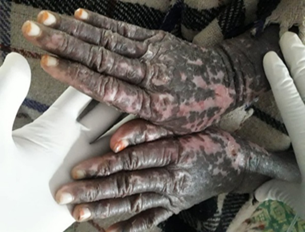Abstract
A rare phototoxic dermatological reaction seen in Indian Sub-continent, known as Phytophotodermatitis, occurs with exposure to ultraviolet light after contact with certain plant chemicals. Phytophotodermatitis named from the terms ‘phyto’ means plant, ‘photo’ means light, and ‘dermatitis’ means skin inflammation. The signs and symptoms of Phytophotodermatitis typically initiated 24 hours after comes in contact with skin, and the peak is reached between 48 to 72 hours. The indications may be from mild or severe. The signs are redness, tenderness, burning sensation, pain, inflammation, itching, blistering, thickened layer of skin after blisters rupture. The area of blisters is usually asymmetrical in shape. These are seen in the areas of the skin, that were exposed to the chemical. For example, the drip form of blister seen in the skin if it is exposed to fruit juice. If the skin were brushed against a plant, it would show streaks like pattern. Though the early symptoms subside, within 7-14 days, signs of blackening of the skin may show hyperpigmentation. This stage of Phytophotodermatitis is known as post-inflammatory pigmentation and might last for many months. In some cases, the affected person will have a very mild inflammatory reaction, if they are exposed to sunlight, while some may not even know that they experienced a reaction. The hyperpigmentation is the initial sign to know that they have got Phytophotodermatitis. Initial symptoms get aggravated because of wet skin, sweat and heat. Darkening of skin-colour is observed in the persons while they are exposed to sunlight. In this case, we are reporting about a patient having this condition and the cause for the occurrence.
Full text article
Authors

This work is licensed under a Creative Commons Attribution-NonCommercial-NoDerivatives 4.0 International License.

